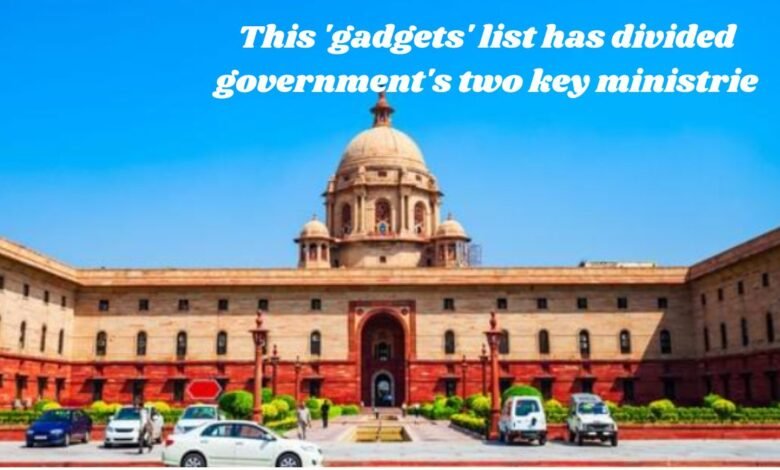This ‘gadgets’ list has divided government’s two key ministrie
A 'gadgets' list sparks division between two key government ministries, highlighting differing priorities and concerns.

The recent debate surrounding the ‘Gadgets’ list has highlighted a significant rift between two key government ministries, drawing considerable public and media attention. This list, which details a wide array of technological devices, has become a contentious issue between the Ministry of Technology and Innovation and the Ministry of Economic Affairs. The significance of the list extends beyond mere inventory, touching upon broader themes of technological advancement, economic growth, and regulatory frameworks.
At the core of this controversy lies the differing perspectives of the two ministries on the role and management of the gadgets listed. The Ministry of Technology and Innovation views the list as an essential tool for promoting technological development and facilitating innovation-driven growth. For this ministry, the gadgets represent the cutting edge of technological progress, crucial for maintaining the country’s competitive edge in the global tech landscape.
Conversely, the Ministry of Economic Affairs approaches the list from a regulatory and economic standpoint. It argues that the proliferation of certain gadgets can have significant economic implications, including impacts on trade balances, consumer spending patterns, and market dynamics. The ministry is particularly concerned with the potential for market saturation, regulatory challenges, and the economic stability of local industries that might be affected by an influx of advanced technological devices.
The main points of contention revolve around the criteria for including devices on the list, the potential economic impacts of widespread gadget adoption, and the regulatory measures needed to manage this process. Both ministries have valid concerns, and the disagreement underscores the complex interplay between technological innovation and economic regulation. Understanding the nuances of this debate is crucial for appreciating the broader implications for policy-making and the country’s technological trajectory.“`html
The Ministries Involved and Their Roles
The ongoing debate over the gadgets list involves two key government ministries: the Ministry of Technology and Innovation (MTI) and the Ministry of Trade and Commerce (MTC). Each ministry has distinct responsibilities, yet their roles intersect when it comes to the regulation and distribution of technological gadgets.
The Ministry of Technology and Innovation (MTI) is primarily responsible for fostering technological advancements and ensuring the integration of innovative solutions into various sectors. Key responsibilities of MTI include:
- Overseeing research and development in technology
- Implementing policies to promote technological innovation
- Regulating the import and export of technological devices
- Ensuring compliance with international tech standards
Conversely, the Ministry of Trade and Commerce (MTC) focuses on promoting national and international trade, ensuring fair trade practices, and supporting economic growth. The main responsibilities of MTC are:
- Regulating domestic and international trade
- Setting tariffs and trade agreements
- Facilitating market access for local businesses
- Monitoring and controlling the quality of imported goods
The clash between MTI and MTC arises from their overlapping duties concerning the gadgets list. While MTI emphasizes the importance of technological standards and innovation, MTC prioritizes trade facilitation and economic interests. This divergence in priorities has led to disagreements on the regulation and distribution of gadgets.
| Ministry | Primary Responsibilities | Stance on Gadgets List |
|---|---|---|
| Ministry of Technology and Innovation (MTI) |
| Prioritizes technological standards and innovation |
| Ministry of Trade and Commerce (MTC) |
| Focuses on trade facilitation and economic growth |
Key Points of the Gadgets List Controversy
The dispute between the two key government ministries revolves around a list of gadgets, each of which has sparked significant contention. Below, we delve into the specific issues causing friction, listing the gadgets in question and the differing perspectives from each ministry. We’ll also explore the legal and regulatory implications associated with this list, offering a comprehensive understanding of the ongoing dispute.
1. Surveillance Cameras
The Ministry of Security advocates the use of advanced surveillance cameras for enhanced public safety and crime prevention. However, the Ministry of Privacy raises concerns about potential infringements on citizens’ privacy rights. They argue for stricter regulations to ensure data protection and limit surveillance scope.
2. Drones
The Ministry of Transportation is in favor of utilizing drones for efficient delivery services and traffic monitoring. Contrarily, the Ministry of Defense highlights security risks, including the potential for unauthorized airspace breaches and misuse by malicious entities. They call for stringent operational controls and usage restrictions.
3. Biometric Scanners
The Ministry of Health supports the adoption of biometric scanners for secure, efficient patient identification in healthcare facilities. The Ministry of Justice, however, raises alarms over potential data breaches and misuse of sensitive personal information. They demand robust legal frameworks to safeguard biometric data.
4. Smart Home Devices
The Ministry of Technology promotes smart home devices for their convenience and energy efficiency benefits. In contrast, the Ministry of Interior expresses concerns about cybersecurity vulnerabilities and the risk of unauthorized access to personal data. They advocate for stringent cybersecurity standards and consumer education on secure usage.
Legal and Regulatory Implications
The gadgets list has significant legal and regulatory implications. For instance, the deployment of surveillance cameras and drones requires compliance with existing privacy laws and airspace regulations, respectively. Biometric scanners necessitate adherence to data protection legislation, while smart home devices demand rigorous cybersecurity protocols. The ministries must navigate these legal landscapes to find a balanced approach that addresses both innovation and security concerns.
In conclusion, the clash over the gadgets list highlights the complex interplay between technological advancements and regulatory frameworks. Each ministry’s perspective underscores the need for a collaborative effort to develop policies that safeguard public interests while fostering innovation.
Potential Resolutions and Impact
The ongoing controversy between the two key government ministries over the ‘Gadgets’ list has generated numerous discussions about potential resolutions. A variety of proposed compromises have emerged, each aiming to address the concerns of both parties while minimizing the impact on the public. One suggested solution involves forming an inter-ministerial committee to oversee the approval and regulation of gadgets. This committee would include representatives from both ministries, ensuring that all perspectives are considered and balanced decisions are made.
Another proposed resolution is the creation of a public consultation process, allowing citizens and industry stakeholders to provide input on the ‘Gadgets’ list. This could lead to more transparent and democratic decision-making, fostering greater public trust in government actions. Additionally, some have suggested implementing a phased approach to the regulation of gadgets, allowing for gradual adjustments and minimizing disruptions for businesses and consumers.
Analyzing the feasibility of these solutions reveals both strengths and weaknesses. For instance, the inter-ministerial committee could facilitate better collaboration and compromise, but it may also lead to slower decision-making processes. Similarly, public consultations could enhance transparency and inclusivity, but they might also result in conflicting opinions that are challenging to reconcile. The phased approach to regulation offers the advantage of flexibility, but it may lack the decisiveness needed to address urgent issues.
The broader implications of this dispute on policy-making and inter-ministerial cooperation are significant. Should a resolution be reached, it could set a precedent for how similar conflicts are managed in the future, potentially leading to more streamlined and cooperative governance. Conversely, a prolonged or unresolved conflict could undermine the effectiveness of governmental operations and erode public confidence in the ability of ministries to work together for the common good.
- OPEC+ says goodbye to its $100-a-barrel oil quest
- The Next Notcoin? Telegram-Based Game ‘Hamster Kombat’ to Launch Token on TON
- The Future of Work is Now: Embracing Remote Work and Hybrid Models
Potential resolutions to the Gadgets list controversy present a range of pros and cons. While each proposed solution has its merits and drawbacks, the ultimate choice will need to balance the interests of the government, stakeholders, and the public to achieve a harmonious and effective outcome.



